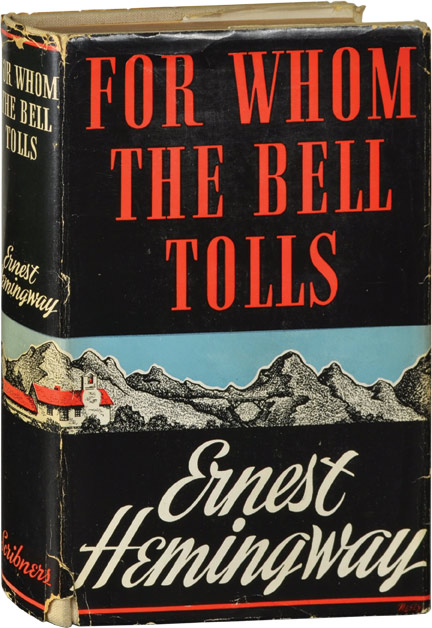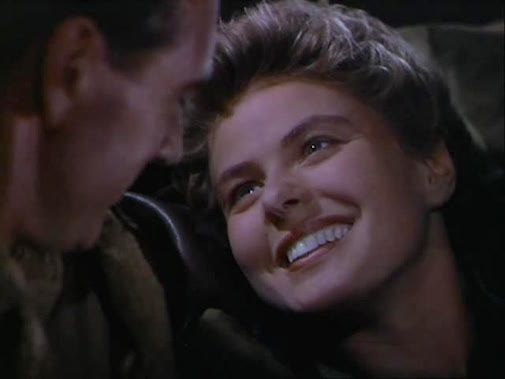We continue our Ingrid Bergman Centennial with Andrew Kendall on For Whom the Bell Tolls (1943)
 It's difficult to speak of Ingrid Bergman without consider her place in Oscar history. She's one of the few people to win three acting Oscars. And, she's fourth (only to Kate, Meryl and Bette) when it comes to Oscar's Actress Hierarchy. For modern fans, then, the celebrity of that first nomination is a curio regardless of its quality. When did Oscar first bite? For Ingrid it came four years (and five films) after her Hollywood debut. Not for that year's best picture winner Casablanca, but for the adaptation of For Whom the Bell Tolls. Casablanca, and Ingrid's "Ilsa," have endured as such integral parts of film culture that her work in For Whom the Bell Tolls immediately faces the scrunity of living up to it. Why the vote for this over her work there?
It's difficult to speak of Ingrid Bergman without consider her place in Oscar history. She's one of the few people to win three acting Oscars. And, she's fourth (only to Kate, Meryl and Bette) when it comes to Oscar's Actress Hierarchy. For modern fans, then, the celebrity of that first nomination is a curio regardless of its quality. When did Oscar first bite? For Ingrid it came four years (and five films) after her Hollywood debut. Not for that year's best picture winner Casablanca, but for the adaptation of For Whom the Bell Tolls. Casablanca, and Ingrid's "Ilsa," have endured as such integral parts of film culture that her work in For Whom the Bell Tolls immediately faces the scrunity of living up to it. Why the vote for this over her work there?
But, it’s essential to remember that films and awards as creatures of their time. At the time of its production Casablanca was merely a minor World War II drama and literary adaptations were all the rage (from 1937 through 1942 every Best Picture winner was an adaptation of a recently pubished text). The adaptation of the literary triumph of 1940 was the bigger ticket. Ingrid was desperate for the role and Hemingway also loved the idea. In a 1971 interview Bergman revealed that Hemingway, a writer typically averse to being too involved in adaptations of his work, lobbied significantly for Bergman to get the role even reportedly sending her a copy of the novel with the inscription
Paramount, on the other hand, was looking at other actresses, and though David Selznick was eager to lend Bergman out, orchestrating machinations like having Bergman photographed by Life magazine with Martha Gellhorn (Hemingway’s wife), Vera Zorina was cast. It wasn’t until Casablanca was wrapping that word from Paramount indicated they were unhappy with Zorina’s performance. Would Ingrid be willing to do an official audition? She was and she did. She won the part.
And, yet, to look at For Whom the Bell Tolls, the tale of the America university instructor helping the Spanish rebels during the Civil war, it is not quite discernible why Ingrid was so certain that this film would cement her ability as a dramatic performer. Maria, is a young Spanish woman whose life has been ruined by her parents' execution at the hands of Fascist. She currently lives in the guerrilla camp our protagonist has infiltrated playing daughter and helper to de facto leader of the group Pilar. Gary Cooper’s republican rebel falls in love with her. Maria herself has no dramatic arc, just a romantic one. As the rebels plot to blow up a bridge Maria “falls in love” with Roberto and relays her history as a hater of fascism. It’s an incredibly passive role to the point that it strains credulity to consider her the lead (Incidentally, Katina Paxinou who won the Oscar for Supporting Actress for this same film, received a runner-up citation from the New York Film Critics Circle Awards for Best Actress).
Though Cooper nails Roberto's world-weariness, he's not at his best here, dulling any interest we might have in him or his quest. It is left to Ingrid then, in the thankless tradition of so many female roles in blockbusters, to give him added dimenion by her sincere devotion. The issue of Ingrid Bergman in For Whom the Bell Tolls isn't that her talents had yet to develop; the problem is the film is hardly interested in them.
Still, there are moments to savour. She gives good face.


Three scenes are key to her performance: a confession to Roberto about her treatment in the hands of the fascist (a rape which the film does not explicitly state but Ingrid intimates); a passioned quasi-monologue which Ingrid prays for Roberto’s safety; And the sad finale.
For Whom the Bell Tolls pales against her later Oscar-nominated work, but must have registered strongly at the time. It did at least prove that she couldn't be lost in an ensemble with its focus elsewhere (the role is a sliver, and yet she registers), and, in combination with Casablanca, it proved her leading lady bonafides as one of the great romantic heroines. Even with unflattering hair, her glamour cannot be diminished.
The movie itself fades in memory but her expressive face isn't to be forgotten. It's a world cinema treasure.
